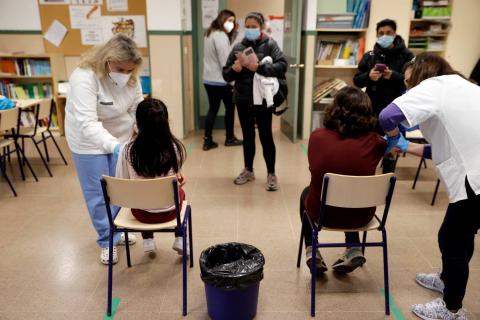How did it all start?
On 6 April 2022, the UK Health Safety Agency (UKSHA) reported that it was investigating several cases of hepatitis of unknown origin after the Royal Hospital for Children in Glasgow, Scotland, reported an atypical number of severe cases in young children observed during three weeks in March. England then found dozens of suspected cases, prompting a nationwide alert. Later, the European ECDC, the WHO and the US CDC all joined the international alert.
Why has the alarm been raised?
Mild hepatitis is common in children after numerous infections. The alarm was raised for several reasons:
Firstly, the severity of the pictures in previously healthy children has drawn the attention of doctors and researchers. Approximately 10 % of the cases found to date have required a liver transplant. In addition, one child has died.
Secondly, the most common viruses associated with hepatitis (hepatitis A to E viruses) were not detected.
Finally, although cases of hepatitis of unknown origin occur in children every year, countries such as the UK, Ireland and the Netherlands have reported higher than expected cases for this time of year.
Where are there cases?
To date more than a dozen countries have found cases in their territory, and the total number is close to 200. In Spain, 8 confirmed and 5 probable cases have been found.
What ages are affected?
Cases range from one month old to 16 years old, but most are under 10 years old.
Why are so many cases being found all at once?
Every year there are cases of unfiliated hepatitis (of unknown origin), so finding cases is not in itself a warning sign. In fact, it is normal that countries are starting to detect them now that they know to look. Although many of the children showed symptoms in March, some cases date back to January or even autumn last year.
So it is not finding cases that is remarkable, but finding cases above what is expected, as the UK, Ireland and the Netherlands have already done. Spain has found 8 confirmed and 5 probable cases up to 22 April, but has assured that these figures are not atypical.
For these reasons, not all cases that countries are reporting need to be confirmed. In addition, different places are using different case definitions, although the WHO has tried to establish a common one.
Why is everyone talking about adenovirus?
Adenoviruses (in particular type F41) have been detected in a majority of the cases tested. For example, the latest British data reveal that 40 out of 53 patients tested were positive. In contrast, SARS-CoV-2 was found in only 10 of the 60 cases tested.
However, this type of adenovirus is not associated with severe hepatitis in healthy children as seen so far, although it is associated with severe hepatitis in immunocompromised children. This has led researchers to suspect that, if adenovirus is involved, other factors may be at play.
Could it be due to covid-19?
The coronavirus has been associated with hepatitis in children in a few cases, but the fact that alarm bells have not been sounded until 2022, after millions of infections worldwide, has led researchers to doubt that SARS-CoV-2 is involved or, if it is, that it is acting alone.
Active SARS-CoV-2 infection has not been detected in most of the children, but countries such as Israel have gone further in their analysis: according to their data, 11 of the 12 reported cases (unconfirmed and, in fact, not hospitalised) had had covid-19 in the past year. However, given the high prevalence of the coronavirus, this need not mean anything.
Still, one hypothesis is that past SARS-CoV-2 infection could be a cofactor in these cases.
In summary, what are the main hypotheses?
The fact that adenovirus alone does not seem to explain the hepatitis cases has led the main hypotheses to speak of "co-factors", whereby there would be a second actor on the scene collaborating with the adenovirus.
The "co-factors" listed are: lack of susceptibility due to lack of exposure of young children during the pandemic, previous SARS-CoV-2 infection, co-infection of the two viruses and some kind of environmental exposure.
Researchers are also assessing other possibilities such as a new adenovirus variant, an environmental agent (such as a drug or toxin), a new pathogen and even a new variant of SARS-CoV-2.
Although adenovirus has made headlines, the uncertainty is still high.
Is it possible that neither adenovirus nor coronavirus is involved?
Finding the culprit in these hepatitis cases is more difficult than it seems: although adenovirus has been found in many patients and SARS-CoV-2 in some, both viruses are highly prevalent in the paediatric population. Countries such as the UK and the Netherlands, for example, have announced that they were observing a higher than usual circulation of adenoviruses.
The viruses tested so far are still the most commonly sought viruses, which include adenovirus and SARS-CoV-2. This is why some researchers have expressed concern that both viruses may be nothing more than a red herring.
Could it be due to the covid-19 vaccines?
This is one of the few hypotheses that can be ruled out. The vast majority of those affected were not vaccinated. In fact, in countries such as the UK, vaccination for 5-11 year olds started only a few weeks ago, and in other places such as the US, vaccination has not started for children under 5.
What about confinements and masks?
Both the WHO and the European ECDC and UKSHA are assessing the possibility that "increased susceptibility among young children following low levels of adenovirus circulation during the pandemic" is one of the factors involved.
However, this is more complex than attributing these illnesses to confinement and masks.
In countries like England, the youngest children have not worn masks, even at school. The word "containment", on the other hand, has become an umbrella term used to refer to all sorts of measures employed during the pandemic, and some places where cases have been observed (such as Japan or the state of Alabama) have not applied strict containment. In others, such as Spain, these took place two years ago.
The covid-19 pandemic has disrupted the dynamics of viruses such as influenza and adenoviruses, but the reasons why it has done so are multifactorial.
Is it possible that it is all a false alarm?
There is a possibility that the observed patterns are a very rare, previously unobserved side effect of hepatitis infections, as noted by the WHO in one of its reports. In this case, the higher number of infections experienced today in countries such as the UK, coupled with increased surveillance, would have allowed this effect to be discovered. Additionally, the lack of immunity in young children caused by the pandemic may have played a role.
This possibility has been much debated by UK researchers.
Is there cause for concern?
So far, few cases have been found and most of the children have recovered. The relevance of this issue lies in the lack of knowledge of the agent responsible, coupled with increased vigilance and media attention as a result of the pandemic. However, the situation is one of great uncertainty and constant evolution.
When will we have the answer to this mystery?
Finding the culprit(s) is not easy. The head of the Hepatology and Liver Transplantation group at the La Fe Health Research Institute, Marina Berenguer, explained a fortnight ago that the investigation would take weeks.




